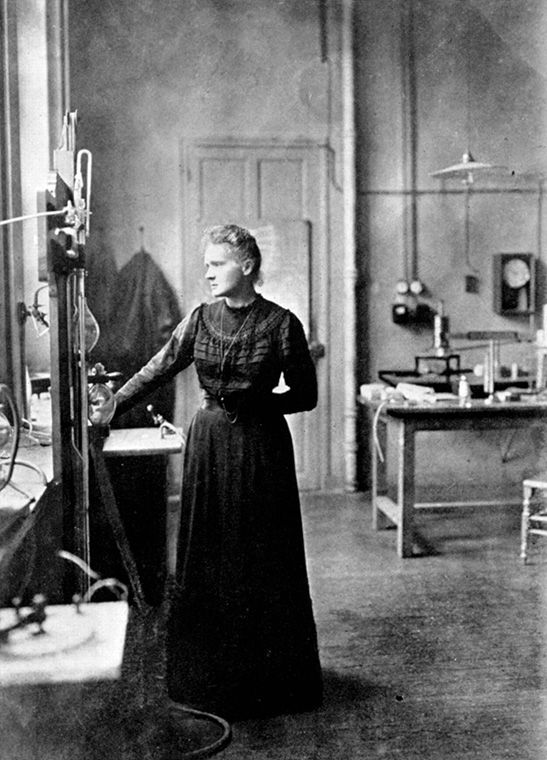‘STEM’ disparity has early origin
Portrait of Marie Curie in her laboratory
December 1, 2014
The gap between the sexes in the fields of science, technology, engineering and mathematics has narrowed considerably since the 1970s. Although that disparity has been addressed in certain respects, the root problems that create the gender imbalance take hold much earlier in women’s lives.
A report published online Oct. 22 in the journal Psychological Science in the Public Interest found the experience of young and mid-career women in math-intensive fields to be similar to those of their male counterparts. However, negative assumptions made about the respective science and math abilities of the genders were evident in kindergarten-age children and were observed to only increase with time.
“The big finding was the question of what happens after you’re at the point where you have your doctorate and you’re applying for jobs in the academic community,” said Diane Halpern, dean of Social Sciences at the Minerva Schools at the Keck Graduate Institute.
The authors reported that there is generally no discrimination against women who apply for professorships after college, according to Halpern, whose commentary on the findings was published alongside the research.
“If anything, it seemed to be that people were more biased toward women. But only at the point for people who’ve already gotten their doctorate and have a successful career before applying for their first academic position,” Halpern said.
Part of the problem is the type of opportunities that parents unconsciously provide to their children, said Cathy Pieronek, assistant dean of academic affairs and director of the Women’s Engineering program at the University of Notre Dame.
Pieronek said the parents of young children may give their sons more chances to explore activities that would lead them to pursue engineering, and they may encourage their daughters to cultivate interests in more passive activities. She said this type of influence at such an impressionable age can lock children’s thinking into one mode or another. She also said it becomes increasingly difficult for young students to feel confident in STEM courses—regardless of gender—once they are off of those curricular tracks.
Part of the disparity results from academic options being cut off at an early age for both men and women. Studies show that in high school, girls take more math and science credits and earn higher grades in those classes than their male peers, Pieronek said.
Because colleges take both academic record and curriculum variety into consideration, young women tend to meet the academic standards set for them in math and science, she said, adding that women subsequently drift away from those subjects because they have reached the academic benchmark.
However, evidence does exist that gender stereotyping may affect the judgment of potential employers, grant funders and performance evaluators, according to Anthony Greenwald, a psychology professor at the University of Washington.
“The other way in which gender stereotypes affect women’s career progress is that women actually have internalized these stereotypes,” Greenwald said. “They know them well.”
The idea that women have a traditional role to play in society—one that is associated with home and family rather than a STEM-intensive career—is shown clearly in association tests measuring career and gender stereotypes, according to Greenwald.
“That’s not traditional meaning long-past and gone, but still a current tradition,” Greenwald said. “This is a force that’s not only operating in those who are judging women, but in women themselves. The discomfort that women feel because of the stereotypes that have been implanted by the culture … makes it more difficult for them to stay in these career paths.”
Pieronek said the standards for entering into STEM-oriented career paths may have been so narrowly defined for so long that reevaluating who set the standards and why may be necessary.
“When you start to get to the core of what you really need to be successful in engineering, you open the field up to not only women, but underrepresented minorities and men who aren’t like the men who defined the standards for success,” Pieronek said.
Although the data analyzed in the Psychological Science in the Public Interest report showed that the number of women entering fields like engineering has been slowly but steadily increasing, less success has been seen in bringing more men into traditionally female-dominated fields such as education, Halpern said. This can make the term “STEM” somewhat of a misnomer because science-oriented disciplines such as biology have nearly equal proportions of men and women, as opposed to a field like engineering.
“It’s probably more useful to think of it as math-intensive fields and not math-intensive fields,” Halpern said. “That’s where you see the largest discrepancies between men and women. Clearly, there are plenty of women with high ability in math who opt out of these fields. I see it as part of a broader question about gender segregation in the workplace and all of the variables that affect our individual choices.”








